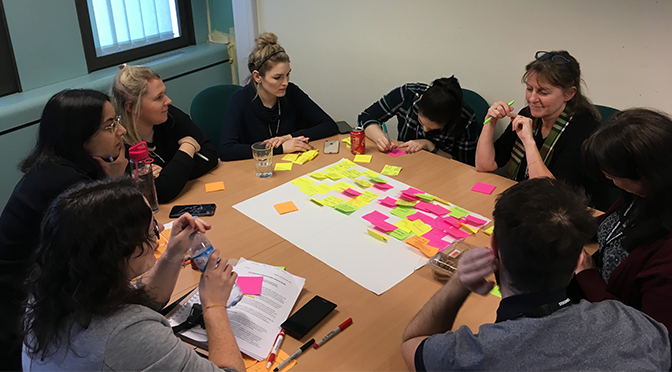Our transformation strategy is increasingly focussed on Service Design – putting people at the centre of everything, experiencing our services through the eyes of the customer and looking at the end to end journey.
We are growing this way of working beyond the digital team to empower our service managers, so they better understand their customers’ journeys and own their service redesign. We are being supported by User Experience Consultants Sigma and in this blog, Francis from Sigma describes the development of a strategy to help with this.
We have been working with Stockport Council since 2017, to help them embed and nurture their in-house service design function.
Most recently, we’ve worked alongside Lisa and Kieran, two talented and enthusiastic service designers, in order to maximise the impact of their work. Rather than trying to tell them “how it is done” (they are already very capable designers!), we chose to observe, explore, and then respond in a collaborative way.
Together, we have begun to develop a strategy that will empower service teams at the council to design the services that they know better than anyone. A key part of that is a toolkit designed with and for service teams.
Taking time to understand the current situation
We ran workshops and spoke to staff who work with Lisa and Kieran, learning about the council, and how the service designers interact with people in other teams, and even people’s hopes and fears regarding service design.
Working together to experiment with new tools and approaches
With Lisa and Kieran, we mapped out projects that they had already worked on, using well-known tools and approaches of service design itself. A retrospective “as is” journey map of a project is a useful way to see who was involved, how they communicated, what happened, and where there are opportunities for both improvement and learning.
Shifting focus to the service teams
We conducted interviews with some of the service team members, to get a better idea of their needs, frustrations, fears, and their experiences of having worked with service designers. For most, this was a very new way of working but an exciting one, too. Staff need to understand what to expect, and how they will work together to improve a service.
Lisa discussed with us the concept of a service design roadmap, drawing on work from Frida Almquist. We agreed that this might be a good way to communicate the nature of the work, and to help with starting off and handing over. We were able to adapt the model that we use in Sigma to think about our work (which owes a lot to Richard Rumelt’s thinking on strategy!), and that shows broad phases of work, as well as suggestions for what would happen when, and with whom.

This diagram describes the end-to-end process of service improvement, as well as describing what kinds of activities happen at different stages, and a roadmap that suggests who does what, and when.
We believe that this will contribute to the confidence and readiness that teams will have to work together in new ways, and to the teams’ sense of owning the service design.
Developing a toolkit with and for service teams
In concentrating on service teams, we came to understand that they would benefit from a toolkit that is made with and for them, rather than creating yet another toolkit aimed at [service] designers, like the many already available online. Essentially, we are aiming for a toolkit that will support design-led change for service teams.
This was a key pivot point in our work together and allowed us to imagine something that will really help the people who have to improve and deliver services, and that allows the services designers to act as choreographers and stewards of the work.
This toolkit will be available to all our service teams, so if you’re part of Stockport Council and would like to get involved in helping us co-design it, please get in touch.
For regular updates from the #DigitalStockport blog sign up for email alerts.

